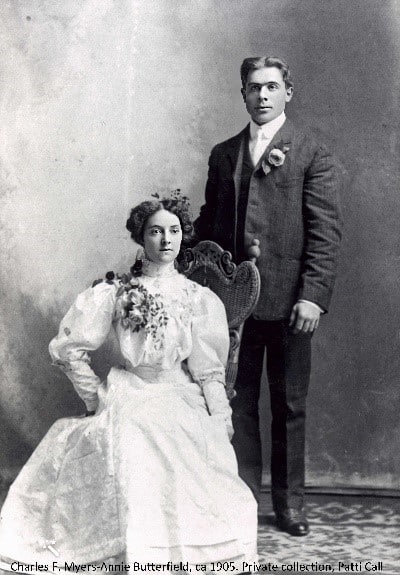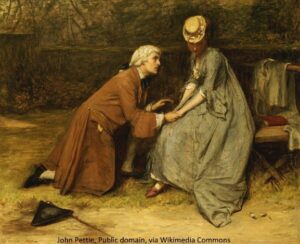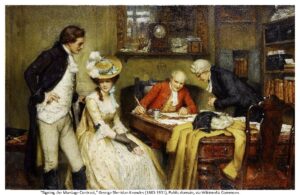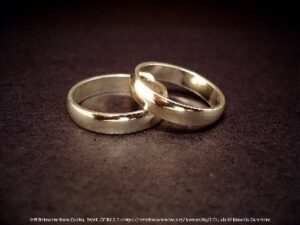Marriage Banns, Licenses, Bonds and Allegations
 10
10Feb
 Love is in the air! With Valentine’s Day just around the corner, let’s take a look at different records that were generated in England as couples tied the knot!
Love is in the air! With Valentine’s Day just around the corner, let’s take a look at different records that were generated in England as couples tied the knot!
In 1604, the Church of England established and ratified a universal set of protocols for ecclesiastical matters so the same procedures would be followed by every congregation. These rules were known as canons, and all religious events—including marriages—were performed according to 1604 Canon Law.[1] There were different procedures that could be followed prior to a marriage, including the posting of banns, obtaining marriage licenses, and signing marriage bonds and allegations.
Banns
 The simplest and most traditional procedure prior to a marriage was the posting of banns (an ancient term meaning proclamation). For three consecutive Sundays, the parish priest would announce a couple’s intent to marry, giving the public time to report any reason why the marriage should not take place. Some impediments to marriage could have been an underage bride, a familial relationship between the bride and groom, or a groom who had a wife and children elsewhere. If there were concerns, three weeks was ample time to alert church authorities and prevent the marriage.
The simplest and most traditional procedure prior to a marriage was the posting of banns (an ancient term meaning proclamation). For three consecutive Sundays, the parish priest would announce a couple’s intent to marry, giving the public time to report any reason why the marriage should not take place. Some impediments to marriage could have been an underage bride, a familial relationship between the bride and groom, or a groom who had a wife and children elsewhere. If there were concerns, three weeks was ample time to alert church authorities and prevent the marriage.
Some parishes had a separate section of the register for banns, and others may have recorded the banns and the marriage ceremony in the same document. Banns can be useful for determining an approximate marriage date if the marriage registers were lost or damaged, although a banns record is not necessarily proof that the marriage took place. On rare occasions, weddings were called off due to concerns raised during the banns process, or simply because the bride or groom had a change of heart.
Today, weddings performed in the Church of England are still legally required to post banns. The announcement of a marriage must be made on three Sundays in three months. Reading the banns is seen as a celebratory announcement, and the couple often invites family and friends to attend church to hear their banns read. Couples who do not have three weeks to post banns are allowed to marry by following the Common License procedure.[2]
Marriage Licenses
Not everyone wanted to inform the entire parish of their intent to marry. For those people, there was the option of paying for a marriage license. The 1604 Canon Law stated that marriage licenses should not be granted without posting banns for three Sundays, unless the license was requested by “such Persons only as be of good State and Quality, and that upon good Caution and Security taken.”[3] Couples in a higher social or economic stratum would fit the description of “good state and quality.” If a license was granted, the couple could marry without posting banns and on their own timeline, as long as four conditions were met. First, there could be no impediment to the marriage. Second, there could be no controversy regarding any previous marriage by either party. Third, the couple needed to have parental consent. Fourth, the marriage must be performed publicly in a parish church, and between the hours of 8 AM and noon.
 Marriage licenses were obtained from the bishop of the diocese where the couple lived. The marriage had to take place within that diocese, usually in the bride’s or groom’s home parish.[4] The fee for a license was typically more money than was easily affordable, but not completely out of reach. The benefits were the convenience of not waiting three weeks to post banns, and the ability to maintain a degree of privacy. Licenses were requested if the bride was pregnant and a birth was imminent, if the groom was about to depart for military operations, or if the parties were of a higher social class and wanted the freedom of marrying at their convenience.
Marriage licenses were obtained from the bishop of the diocese where the couple lived. The marriage had to take place within that diocese, usually in the bride’s or groom’s home parish.[4] The fee for a license was typically more money than was easily affordable, but not completely out of reach. The benefits were the convenience of not waiting three weeks to post banns, and the ability to maintain a degree of privacy. Licenses were requested if the bride was pregnant and a birth was imminent, if the groom was about to depart for military operations, or if the parties were of a higher social class and wanted the freedom of marrying at their convenience.
The marriage itself was recorded in the parish register, often (but not always) with a notation that the marriage was performed “by license.”[5] The marriage license was good for three months from the date issued, but again, the existence of a license is not proof that the marriage took place. The bride or groom may have decided against marriage, let that license lapse, and filed for another marriage license to a different partner at some later date.
Marriage Bonds and Allegations
Marriage bonds and allegations were only filed in the case of a marriage by license. The phrase “upon Good Caution and Security taken” in the 1604 Canon Law was taken very literally. One of the parties—usually the groom—would allege in a sworn statement that there was no reason why the couple could not marry, and that the marriage would be performed under the requirements of Canon law. Other witnesses would also sign the allegation.[6]
 To provide additional assurance of a legal marriage, a surety bond was required along with the allegation.[7] The bridegroom or one of the witnesses would promise to forfeit a large sum of money, often more than one year’s wages, if any evidence of a familial relationship or a previous betrothal to someone else might prevent the planned marriage. The large amount of bond was mostly symbolic, meant to underscore the seriousness of the marriage allegation. The witnesses or prospective bridegroom did not actually have to possess large sums of money in order to post the bond.
To provide additional assurance of a legal marriage, a surety bond was required along with the allegation.[7] The bridegroom or one of the witnesses would promise to forfeit a large sum of money, often more than one year’s wages, if any evidence of a familial relationship or a previous betrothal to someone else might prevent the planned marriage. The large amount of bond was mostly symbolic, meant to underscore the seriousness of the marriage allegation. The witnesses or prospective bridegroom did not actually have to possess large sums of money in order to post the bond.
Marriage allegations were recorded as early as 1660, and are useful because they give the names of the couple, the parish of residence, the groom’s occupation, and the ages of the couple. If either the bride or groom were younger than twenty-one, their parents’ names would also be recorded in the allegation.[8]
Marriage was a process requiring several steps prior to the actual event. The marriage banns, licenses, allegations, and bonds can provide additional insight about your ancestors. Our professional genealogists can search these documents to enrich your family history!
Patti
[1] “1604 Canon Law,” Anglican (https://www.anglican.net/doctrines/1604-canon-law : accessed 22 Dec 2022), citing Constitutions and Canons Ecclesiastical (1604).
[2] “Reading the Banns,” webpage, Church of England (https://www.churchofengland.org : accessed 22 Dec 2022)
[3] “1604 Canon Law,” Anglican.
[4] “Marriage allegations, bonds and licenses in England and Wales,” webpage, FamilySearch Wiki (https://www.familysearch.org/en/wiki/ : accessed 22 Dec 2022), rev. 8 Dec 2022, 22:01.
[5] Ibid.
[6] “Marriage bonds and allegations,” catalogue, National Archives of the UK (https://discovery.nationalarchives.gov.uk : accessed 22 Dec 2022).
[7] “Marriage allegations, bonds and licenses in England and Wales,” FamilySearch Wiki.
[8] Ibid.
